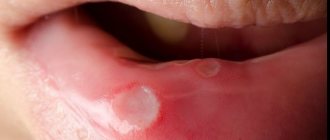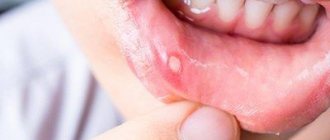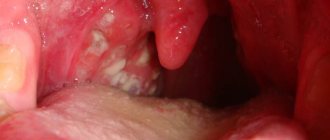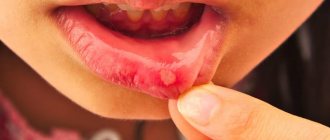How to treat aphthous stomatitis?
Aphthous stomatitis
Aphthous form is the most common type of disease, which affects up to 40% of adults in one form or another at least once in their lives. Whitish oval ulcers appear due to microtraumas, hormonal imbalance, bacterial infection or vitamin deficiency. Diagnostics does not require tests; the dentist visually identifies the problem and prescribes treatment.
In the absence of complications, aphthous stomatitis is treated according to the following scheme:
- Wounds need to be treated up to 7-8 times a day with antiseptic and analgesic ointment - Kamistad, Metrogil-denta and their analogues are suitable.
- After each meal, rinse with a decoction of chamomile, sage, oak bark or calendula. Among the popular pharmaceutical formulations, it is better to buy Miramistin; it is not as toxic as cheap solutions.
- A course of antihistamines - Erius, Cetrin, etc.
- Vitamin complexes - take continuously for at least a month, even if visual symptoms of the disease do not appear.
The aphthous type most often causes relapses, complications and becomes chronic. Therapy should be strictly monitored by several specialists, including a physician, ENT, endocrinologist and allergist.
Treatment methods
Gum treatment is individual. Therapy depends on the specific type of disease. There is no single treatment regimen for stomatitis; the doctor takes into account all the nuances of the pathological process and the characteristics of the body.
- If we are talking about fungal stomatitis, local and oral antifungal drugs must be prescribed. Antiseptic solutions for mouth rinsing are also prescribed.
- In the case of an allergic type, antihistamines are prescribed in combination with anti-inflammatory ointments. Aphthous stomatitis is treated in almost the same way.
- The catarrhal form requires an integrated approach. Drugs to stimulate the immune system, anti-inflammatory ointments, and antiseptic solutions such as Miramistin are prescribed. Pain-relieving ointments may also be prescribed to reduce the intensity of discomfort.
If the disease occurs due to a violation of the integrity of the gums, wound healing ointments are additionally prescribed.
We recommend that you consult a doctor at the first symptoms of pathology. Remember that the disease is easier to defeat at the initial stage.
How to treat candidal stomatitis?
Candidal stomatitis
The causative agent is the candida fungus, which attacks the body's cells with weakened immunity. It is rare in a healthy person, mainly at risk are young children, those who have recently had ARVI and influenza, diabetics and people suffering from tuberculosis. Externally, the disease manifests itself as multiple white deposits on the tongue and upper palate; there may not be severe pain, but swelling of the lips and cheeks is almost always present.
After a comprehensive diagnosis, courses of treatment are prescribed, which include:
- Levarin, daktarin and analogues of antifungal agents.
- Nystatin ointment or miconazole gel - instead of or as an addition to tablets.
- Iodinol or Lugol - treat the entire affected area and adjacent tissues.
- For at least a week, switch to a light diet - steamed vegetables, chicken fillet, it is advisable to give up flour products, fatty, spicy and salty foods.
Treatment
Despite the fact that when stomatitis develops in adults, its symptoms and subsequent treatment are interrelated , that is, based on the manifestation of the disease one can roughly get an idea of the cause, in no case should you self-medicate!
Stomatitis can have several causes, and when treating one, a completely different disease can develop.
It may not be stomatitis at all, but, for example, a simple allergy or herpes.
Active substances contained in both medications and medicinal plants may cause allergies or be contraindicated for some people.
How to treat herpetic stomatitis?
Herpetic stomatitis
The form develops against the background of cold complications, gingivitis and other inflammatory processes in the body. The symptom is the appearance of multiple small rashes on the tongue, gums and inner surface of the cheeks. The pain, as a rule, is much stronger than from aphthous ulcers, but it is not the discomfort itself that is scary, but the consequences - fever and weakness.
Herpes lesions are primarily treated with a course of medications:
- Acyclovir - from 1 to 3 tablets per day.
- Viferon-gel - topically, twice a day, and only after the approval of the attending physician.
- Solcoseryl - temporary pain relief, 15 minutes before and immediately after meals.
- Rinsing with soda creates an additional alkaline environment in the mouth against bacteria.
Ulcerative stomatitis: before and after photos
Mild degrees are characterized by:
- slight bleeding of the gums;
- mouth pain;
- increased salivation;
- swelling of the gums, their pain on palpation.
- The average degree of necrotizing ulcerative stomatitis is manifested by the following symptoms:
- formation of a crusty wound on the edge of the gum;
- severe bleeding gums;
- strong bad breath;
- discharge of pus from periodontal pockets;
- enlarged and painful lymph nodes;
- increase in body temperature to 38 degrees.
In severe cases of necrotizing ulcerative stomatitis, the following manifestations are observed:
- a sharp rise in temperature (even up to 40 degrees);
- severe weakness;
- the formation of very deep ulcers (can reach the jaw bones);
- nausea, vomiting;
- stomach ache.
How to treat catarrhal and ulcerative stomatitis?
Both types of disease are direct consequences of poor oral hygiene or incorrectly selected toothpaste. Most often they are localized deep on the inner surface of the cheeks and closer to the root of the tongue - where the toothbrush cannot reach when brushing quickly. There may be no painful symptoms, but the mucous membrane swells and dries out due to lack of saliva.
Treatment is long, because the main task is to normalize daily hygiene, and only then begin active therapy:
- Rinsing with a solution of furatsilin, rivanol, etc. after every meal.
- Treatment of the affected surface with chlorhexidine.
- A month's course of antibiotics and antifungals.
If stomatitis develops into an ulcerative form, then a local anesthetic gel will not be enough; pentalgin or another analgesic for oral administration is prescribed.
Types of stomatitis
Let's look at the most common forms of the disease:
- Fungal. A symptom of fungal stomatitis is a white coating on the gums. As a rule, the patient suffers from severe itching and burning.
- Allergic. Occurs after direct contact with an allergen.
- Aphthous. Differs from other species in single ulcers.
- Catarrhal. The only type of disease that occurs without ulcers. The main symptom is gum hyperemia.
Only a specialist can determine the specific type of stomatitis. To identify the nature of the pathology, additional studies may be needed, such as a general blood test or scraping from the mucous membrane.
Prevention of stomatitis
You can avoid any form of the disease if you follow a few tips from dentists:
- Chew food thoroughly and slowly - the slightest wound after biting will provoke the appearance of multiple ulcers.
- Do not brush your teeth with a brush that is too hard; it is better to choose medium-hard bristles. At your doctor’s appointment, ask which type of toothpaste is best for you individually.
- Maintain hygiene – cleaning should not be limited to morning and evening. If you cannot use a toothbrush, rinse your mouth with warm water at room temperature after each meal. Ideally, buy a compact irrigator.
- For smokers, reduce the number of cigarettes per day, or give up the bad habit forever. Tobacco smoke not only harms the mucous membrane, but also promotes the growth of fungus and pathogenic bacteria.
- Balance your diet - drink scalding hot drinks as little as possible, reduce sour, spicy, salty and fatty foods in your diet. Give preference to dairy products, white meat and fresh, thoroughly washed fruits.
- Visit the dentist at least twice a year for a preventive examination.
Remedy for stomatitis METROGYL DENTA®
METROGYL DENTA® is a modern remedy for eliminating the causes of painful manifestations of stomatitis. The drug contains chlorhexidine and metronidazole, which reduce the activity of pathogens and promote rapid healing of damage to the oral mucosa.
Up to contents
The information in this article is for reference only and does not replace professional advice from a doctor. To make a diagnosis and prescribe treatment, consult a qualified specialist.
Stages
There are three forms of the disease:
- Easy. Almost no one here has any rashes. Treatment is quick and easy. This stage is called catarrhal stomatitis. In the absence of timely treatment, it moves to the next stage;
- Average. This is the aphthous stage of stomatitis;
- Heavy. This stage is called ulcerative. During this type of disease, necrotic tissue damage may occur.
After some time, all wounds heal, after which only scars and tissue damage remain. But there are certain consequences of stomatitis; it can become chronic. Treatment is possible here, but it takes longer.
Symptoms
It is worth knowing about other manifestations of stomatitis. The most common signs include:
- Initially, the symptoms may resemble a standard cold (headache, joints, muscles, bones hurt, temperature may rise, sometimes a runny nose, pain in the throat);
- the lymph nodes become enlarged, it’s even painful to touch them;
- due to pain, a person or child may completely refuse to eat, and apathy is observed;
- stomatitis can be caused by staphylococcus or streptococcus, and the disease appears against the background of a sore throat. Then the person has purulent discharge, thick saliva containing mucus, and an unpleasant odor from the mouth;
- The soft tissues of the cheeks and lips are damaged, tartar appears, cracks, and the mucous membrane becomes very dry. This is noted in those patients who smoke;
- in the case of a fungal infection as a pathogen, the surface of the mucous membrane is usually covered with a cheesy white coating;
- in the case of an advanced form of stomatitis, rashes appear even on the skin;
- if the disease was provoked by viral agents, then ulcerative and aphthous lesions may also affect other parts.
Inflammation of the oral cavity in a child: causes, treatment
Pathogenic bacteria do not select their hosts based on age; for them, the main factor is a beneficial environment. Children, as a rule, are more susceptible to this type of infection than adults, because... the body is weaker and does not have a strong enough immune system.
If a child has been infected with pathogenic bacteria, this does not mean that the parents are providing poor care; today, the risk zone for children is modern sweets, many of them may already contain strains of viruses, depending on where and by whom they are produced, and as a result, they can cause caries and other dangerous diseases. For example, as a result of an examination, a doctor can diagnose stomatitis.
We are talking not only about school-age children, but also about infants who feed on their mother’s breasts, since bacteria can also be transmitted through milk. Children aged from birth to three years old can suffer from candidal stomatitis. After three years, they may develop herpetic stomatitis. This occurs when a child is denied a pacifier and begins to suck dirty fingers, which leads to the spread of bacteria in the oral cavity and the formation of small ulcers in size and shape. In this case, stomatitis in children in the mouth can be dangerous and treatment must be carried out very quickly, since the child will not be able to eat food at all, which will negatively affect his general condition and activity, not to mention the terrible pain that the child will experience.
School-aged children may also be susceptible to oral inflammation. In them, the disease takes the form of allergenic or aphthozonal stomatitis. It should be noted that an unhealthy lifestyle, unsanitary conditions, dirty cutlery or lack thereof can lead to adults also getting stomatitis. When it comes to children, it is necessary to conduct preventive and educational conversations about the need to always take care of hygiene, because clean hands are a guarantee of protection against the occurrence of stomatitis and intestinal diseases.
Stomatitis is more common in children. This is explained by the fact that in babies the mucous membrane in the oral cavity is much more tender and thinner. This leads to its rapid injury and defeat. The child’s immune system cannot cope with a large number of bacteria, so wounds appear in the mouth, which are quite difficult to cure. At the initial stage, stomatitis in her child can be detected by the mother, who is always next to him. However, you should not experiment with treatment; it is important to identify the cause of the disease and undergo treatment. You can only take precautions by isolating the child in a separate room if there are other children in the family. The reason for isolation is simple: the disease is transmitted through airborne droplets.
What does stomatitis look like in the mouth?
Initially, during stomatitis, the soft tissues located in the oral cavity swell greatly and swell. The mucous membrane may itch and hurt when fingers press on it. In those places where the rash occurs, the skin may become pale or red. Sometimes tissue hyperemia is noted, so the patient may claim that the mouth is on fire. Later, rashes are observed. Their shade, shape, type depends on stomatitis and its type.
Usually the rashes look like oval or round lesions on the skin, there may be plaque, but the disease is always accompanied by pain. There may be a different number of formations.









